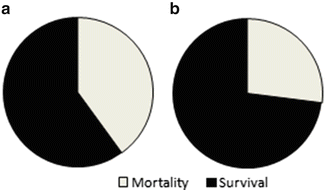2002–2003
2012–2013
Number of babies
Percent
Number of babies
Percent
Early administration of surfactant
Yes
10
67.0
25
75.8
No
5
33.0
8
24.2
Repeated administration of surfactant
Yes
0
0
11
33.3
No
0
0
22
66.7
In Group 02/03, three premature infants (20.0 %) were primarily managed with nasal continuous positive airway pressure (nCPAP) (Fig. 1a). After 2 h on nCPAP, no child from this group had mechanical support of ventilation. In Group 12/13, on the other hand, 18 children (54.5 %) were stabilized with CPAP and 9 infants (33.3 %) required intubation and mechanical ventilation after 2 h on nCPAP (Fig. 1b).


Fig. 1
Number of neonates with primary ventilatory support by nasal CPAP born in 2002–2003 (Panel A) and in 2012–2013 (Panel B)
In Group (02/03), 78.0 % of children suffered from a late respiratory complication of bronchopulmonary dysplasia (n = 7); whereas this pathology occurred in 66.7 % (n = 18) of children in Group (12/13) (p > 0.05). Necrotizing enterocolitis (NEC) occurred in 2 neonates (13.0 %) in Group 02/03 with the duration of parenteral nutrition was 25.9 ± 15.4 days (median 21 days) in this group. In Group 12/13, necrotizing enterocolitis was present only in one patient (3.0 %), although the parenteral nutrition was administered only for 16.4 ± 6.9 days (median 14.5 days).
Retinopathy of prematurity (ROP) occurred in 20.0 % (n = 3) of children in Group 02/03, whereas it was recorded in 27.3 % (n = 9) of newborn infants in Goup 12/13 (Table 2). Mortality in Group 02/03 was 40.0 % (n = 6) and that in Group 12/13 was 27.0 % (n = 9) (p < 0.05) (Fig. 2a, b, respectively).

Table 2
Incidence of retinopathy of prematurity (ROP)
2002–2003 | 2012–2013 | |||
|---|---|---|---|---|
Number of babies | Percent | Number of babies | Percent | |
With ROP | 3 | 20.0 | 9 | 27.3 |
Without ROP | 12 | 80.0 | 24 | 72.7 |

Fig. 2
Mortality rate in neonates born in 2002–2003 (Panel A) and in 2012–2013 (Panel B)
4 Discussion
Despite recent advances in the perinatal management of neonatal respiratory distress syndrome controversies still exist. The aim of updated recommendations is to unite and start to use optimal therapeutic procedures, and to improve quality of care of preterm infants. The present study demonstrates that after the introduction of the European recommendations on the management of neonatal respiratory distress syndrome in preterm infants, clinical outcome of these newborns significantly improved over a decade resulting in a reduction of mortality and morbidity.
Several obstetric and neonatal procedures used in the management of children weighing 501–1,500 g changed in the years 2000–2009. In particular, a wider use of less invasive approach to ventilation has become more common (Soll et al. 2013). Early use of nCPAP led to decreased oxygen demand during the first 10 min, reduced a need for intubation, and shortened the time on mechanical ventilation and hospitalization. Moreover, quality of care of very immature children improved at the delivery room. However, a question of how to achieve a full implementation of the European guidelines on the management of respiratory distress syndrome in all hospitals and workplaces remains open.
< div class='tao-gold-member'>
Only gold members can continue reading. Log In or Register to continue
Stay updated, free articles. Join our Telegram channel

Full access? Get Clinical Tree


